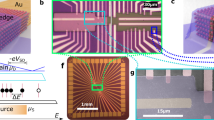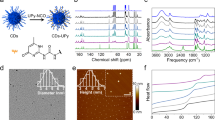Abstract
Graphene and other two-dimensional materials possess desirable mechanical, electrical and chemical properties for incorporation into or onto colloidal particles, potentially granting them unique electronic functions. However, this application has not yet been realized, because conventional top-down lithography scales poorly for producing colloidal solutions. Here, we develop an ‘autoperforation’ technique that provides a means of spontaneous assembly for surfaces composed of two-dimensional molecular scaffolds. Chemical vapour deposited two-dimensional sheets can autoperforate into circular envelopes when sandwiching a microprinted polymer composite disk of nanoparticle ink, allowing liftoff into solution and simultaneous assembly. The resulting colloidal microparticles have two independently addressable, external Janus faces that we show can function as an intraparticle array of vertically aligned, two-terminal electronic devices. Such particles demonstrate remarkable chemical and mechanical stability and form the basis of particulate electronic devices capable of collecting and storing information about their surroundings, extending nanoelectronics into previously inaccessible environments.
This is a preview of subscription content, access via your institution
Access options
Access Nature and 54 other Nature Portfolio journals
Get Nature+, our best-value online-access subscription
$29.99 / 30 days
cancel any time
Subscribe to this journal
Receive 12 print issues and online access
$259.00 per year
only $21.58 per issue
Buy this article
- Purchase on Springer Link
- Instant access to full article PDF
Prices may be subject to local taxes which are calculated during checkout




Similar content being viewed by others
Data availability
All relevant data and computer codes are available from the authors and most of them are included within the Supplementary Information, including sections on modelling and simulations, Supplementary Figs 1–60 and Supplementary Videos 1–12. Correspondence and requests for materials should be addressed to M.S.S.
References
Griffith, A. A. The phenomena of rupture and flow in solids. Philos. Trans. Roy. Soc. London Ser. A 221, 163–198 (1921).
Nam, K. H., Park, I. H. & Ko, S. H. Patterning by controlled cracking. Nature 485, 221–224 (2012).
Kim, B. C., Moraes, C., Huang, J., Thouless, M. D. & Takayama, S. Fracture-based micro- and nanofabrication for biological applications. Biomater. Sci. 2, 288–296 (2014).
Kim, M., Kim, D.-J., Ha, D. & Kim, T. Cracking-assisted fabrication of nanoscale patterns for micro/nanotechnological applications. Nanoscale 8, 9461–9479 (2016).
Zhang, P. et al. Fracture toughness of graphene. Nat. Commun. 5, 3782 (2014).
Yin, H. et al. Griffith criterion for brittle fracture in graphene. Nano Lett. 15, 1918–1924 (2015).
Reina, A. et al. Large area, few-layer graphene films on arbitrary substrates by chemical vapor deposition. Nano Lett. 9, 30–35 (2009).
Kim, K. S. et al. Large-scale pattern growth of graphene films for stretchable transparent electrodes. Nature 457, 706–710 (2009).
Li, X. et al. Large-area synthesis of high-quality and uniform graphene films on copper foils. Science 324, 1312–1314 (2009).
Lee, G.-H. et al. High-strength chemical-vapor-deposited graphene and grain boundaries. Science 340, 1073–1076 (2013).
Mitchell, N. P., Koning, V., Vitelli, V. & Irvine, W. T. M. Fracture in sheets draped on curved surfaces. Nat. Mater. 16, 89–93 (2017).
Zhang, T., Li, X. & Gao, H. Fracture of graphene: a review. Int. J. Fracture 196, 1–31 (2015).
Hsu, P. I. et al. Spherical deformation of compliant substrates with semiconductor device islands. J. Appl. Phys. 95, 705–712 (2004).
Sun, J.-Y. et al. Debonding and fracture of ceramic islands on polymer substrates. J. Appl. Phys. 111, 013517 (2012).
Brandrup, J. & Immergut, E. H. (Eds) Polymer Handbook 2nd edn, Ch. IV (John Wiley & Sons, New York, USA).
Zhang, L. et al. Janus graphene from asymmetric two-dimensional chemistry. Nat. Commun. 4, 1443 (2013).
Dendukuri, D., Pregibon, D. C., Collins, J., Hatton, T. A. & Doyle, P. S. Continuous-flow lithography for high-throughput microparticle synthesis. Nat. Mater. 5, 365–369 (2006).
Walther, A. & Müller, A. H. E. Janus particles: synthesis, self-assembly, physical properties, and applications. Chem. Rev. 113, 5194–5261 (2013).
Splendiani, A. et al. Emerging photoluminescence in monolayer MoS2. Nano Lett. 10, 1271–1275 (2010).
Lee, S., Lee, K., Liu, C.-H. & Zhong, Z. Homogeneous bilayer graphene film based flexible transparent conductor. Nanoscale 4, 639–644 (2012).
Yang, J. J. et al. Memristive switching mechanism for metal//oxide//metal nanodevices. Nat. Nanotech. 3, 429–433 (2008).
Brent, J. R. et al. Production of few-layer phosphorene by liquid exfoliation of black phosphorus. Chem. Commun. 50, 13338–13341 (2014).
Hanlon, D. et al. Liquid exfoliation of solvent-stabilized few-layer black phosphorus for applications beyond electronics. Nat. Commun. 6, 8563 (2015).
Hao, C. et al. Liquid-exfoliated black phosphorous nanosheet thin films for flexible resistive random access memory applications. Adv. Funct. Mater. 26, 2016–2024 (2016).
Grunlan, J. C., Mehrabi, A. R., Bannon, M. V. & Bahr, J. L. Water-based single-walled-nanotube-filled polymer composite with an exceptionally low percolation threshold. Adv. Mater. 16, 150–153 (2004).
Island, J. O., Steele, G. A., van der Zant, H. S. J. & Castellanos-Gomez, A. Environmental instability of few-layer black phosphorus. 2D Mater. 2, 6 (2015).
Huang, Y. et al. Interaction of black phosphorus with oxygen and water. Chem. Mater. 28, 8330–8339 (2016).
Youngwoo, S. et al. A study of bilayer phosphorene stability under MoS2 passivation. 2D Mater. 4, 025091 (2017).
O’Hern, S. C. et al. Selective molecular transport through intrinsic defects in a single layer of CVD graphene. ACS Nano. 6, 10130–10138 (2012).
Koman, V. B. et al. Colloidal nanoelectronic state machines based on 2D materials for aerosolizable electronics. Nat. Nanotech. 13, 819–827 (2018).
Liu, P. et al. Emerging trends in 2D nanotechnology that are redefining our understanding of ‘nanocomposites’. Nano Today 21, 18–40 (2018).
Mahajan, S. G. et al. Sustainable power sources based on high efficiency thermopower wave devices. Energy Environ. Sci. 9, 1290–1298 (2016).
Liu, A. T. et al. Electrical energy generation via reversible chemical doping on carbon nanotube fibers. Adv. Mater. 28, 9752–9757 (2016).
Kunai, Y. et al. Observation of the Marcus inverted region of electron transfer from asymmetric chemical doping of pristine (n,m) single-walled carbon nanotubes. J. Am. Chem. Soc. 139, 15328–15336 (2017).
Cottrill, A. L. et al. Ultra-high thermal effusivity materials for resonant ambient thermal energy harvesting. Nat. Commun. 9, 664 (2018).
Liu, P. et al. Layered and scrolled nanocomposites with aligned semi-infinite graphene inclusions at the plateletlimit. Science 353, 364–367 (2016).
Oomen, A. G. et al. Comparison of five in vitro digestion models to study the bioaccessibility of soil contaminants. Environ. Sci. Technol. 36, 3326–3334 (2002).
Ruby, M. V. et al. Development of an in vitro screening test to evaluate the in vivo bioaccessibility of ingested mine-waste lead. Environ. Sci. Technol. 27, 2870–2877 (1993).
Acknowledgements
This work was primarily funded by a 2015 US Air Force Office of Scientific Research (AFOSR) Multi University Research Initiative (MURI) grant on Foldable and Adaptive Two-Dimensional Electronics (FATE) at MIT, Harvard University and University of Southern California (award no. FA9550-15-1-0514). The authors acknowledge characterization support from The MIT Center for Materials Science and Engineering, and support for graphene synthesis and characterization from the Army Research Office and support via award no. 64655-CH-ISN to the Institute for Soldier Nanotechnologies. P.L. acknowledges the ‘One-hundred Talents Program’ of Zhejiang University. A.T.L. acknowledges the MIT Presidential Fellow programme. D.K. is supported by a Grant-in-Aid for JSPS Fellows (JSPS KAKENHI grant no. 15J07423) and Encouragement of Young Scientists (B) (JSPS KAKENHI grant no. JP16K17485) from the Japan Society for the Promotion of Science. V.B.K. is supported by The Swiss National Science Foundation (project no. P2ELP3_162149).
Author information
Authors and Affiliations
Contributions
P.L., A.T.L. and M.S.S. conceived of the experiments and wrote the paper. P.L., A.T.L. and M.S.S. performed experiments and data analysis. P.L., A.T.L. and M.S.S. designed the physical models to explain the controlled fracture of 2D materials. A.T.L. and M.S. performed the calculations and finite-element simulation. D.K. assisted in fluorescence characterization of the microparticles with MoS2 layers, J.D. assisted with the inkjet printing, and J.F.Y. performed statistical analyses for the memristor data to generate Fig. 3i. V.B.K. assisted with building the memristor function of the microparticles. S.W. and Y.S. assisted in the growth and transfer of 2D materials. M.H.W. set up the flow cell used to track liquid-phase particle translocation. All authors have given their approval to the final version of the manuscript.
Corresponding author
Ethics declarations
Competing interests
The authors declare no competing interests.
Additional information
Publisher’s note: Springer Nature remains neutral with regard to jurisdictional claims in published maps and institutional affiliations.
Supplementary information
Supplementary Information
Supplementary Figures 1–60, Supplementary Table 1, Supplementary References 1–23.
Supplementary Video 1
Strain guided fracture propagation of graphene with stochastic seed crack formation.
Supplementary Video 2
Finite element coarse grained MD simulation for mould-based graphene folding.
Supplementary Video 3
Autoperforation for G-PS-G microparticles—lift-off process on SiO2-Si substrate—I.
Supplementary Video 4
Autoperforation for G-PS-G microparticles—lift-off process on SiO2-Si substrate—II.
Supplementary Video 5
Autoperforation for G-PS-G microparticles—lift-off process on PDMS substrate.
Supplementary Video 6
Control—lift-off process of PS control microparticles without grapheme.
Supplementary Video 7
Flowing and rotating of G-PS-G microparticles in microfluidic channel.
Supplementary Video 8
Magnetic propulsion of Gr-Fe3O4-PS-Gr microparticles.
Supplementary Video 9
Autoperforation for G-PS microparticles with only one layer of graphene (Graphene A).
Supplementary Video 10
Autoperforation for PS-G microparticles with only one layer of graphene (Graphene B).
Supplementary Video 11
The whole process starting from autoperforation, capturing, information write in, lift-off, recapturing to information readout.
Supplementary Video 12
Aerosolization of G-PS-G microparticles with atomizer.
Rights and permissions
About this article
Cite this article
Liu, P., Liu, A.T., Kozawa, D. et al. Autoperforation of 2D materials for generating two-terminal memristive Janus particles. Nature Mater 17, 1005–1012 (2018). https://doi.org/10.1038/s41563-018-0197-z
Received:
Accepted:
Published:
Issue Date:
DOI: https://doi.org/10.1038/s41563-018-0197-z
This article is cited by
-
Colloidal robotics
Nature Materials (2023)
-
Soil-based nano-graphene oxide and foliar selenium and nano-Fe influence physiological responses of 'Sultana' grape under salinity
Scientific Reports (2022)
-
Fabrication of Silver Yolk@Porous Janus Polymer Shell Nanospheres for Synergistic Catalysis
Chinese Journal of Polymer Science (2020)
-
Predicting two-dimensional topological phases in Janus materials by substitutional doping in transition metal dichalcogenide monolayers
npj 2D Materials and Applications (2019)
-
Buffering by buckling as a route for elastic deformation
Nature Reviews Physics (2019)



